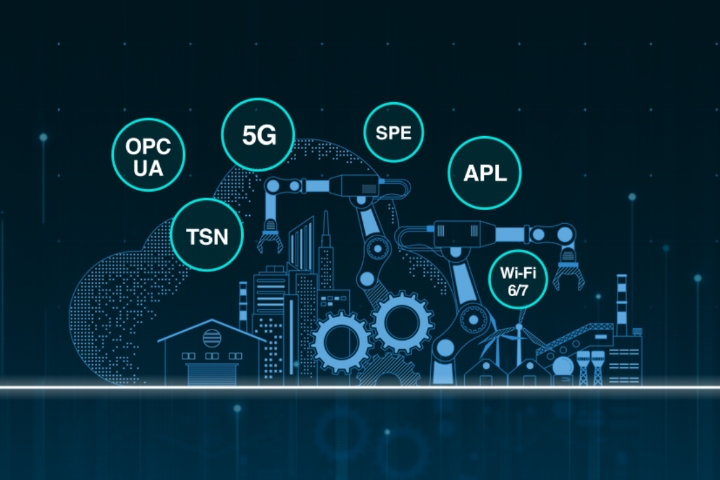As adaptability, productivity, durability, and eco-friendliness become focal points in the post-pandemic era, numerous business pioneers now anticipate the swift arrival of advanced manufacturing. Indeed, emerging technologies and standards like Open Platform Communications Unified Architecture Field Exchange (OPC UA FX), time-sensitive networking (TSN), Wi-Fi 6/7, 5G, and Single-pair Ethernet (SPE)/Ethernet-APL are increasingly being integrated to empower Industrial Internet of Things (IIoT) networks for innovative manufacturing.
Two experienced professionals in the IIoT realm have opted to share their perspectives on the future of advanced manufacturing and the path to get there. Stefan Schönegger, Vice President of Product Management Control Systems, Machine Vision and Networks at B&R Industrial Automation (a segment of ABB Group), collaborates with Jack Lin, Product Manager of Industrial Networking Infrastructure at Moxa, to address five pivotal questions confronting many industries as they devise and deploy industrial networking solutions for smart manufacturing.
1. Why are the pivotal technologies enabling advanced manufacturing so critical and how do they interact with each other?
Stefan: Advanced manufacturing is a technological concept that utilizes interconnected machinery via the Internet to seamlessly oversee the entire production process. The devices in advanced manufacturing consistently gather and scrutinize data from various origins, including real-time information, to facilitate a new level of adaptability and prompt modifications through digital information technologies. Furthermore, data specialists can leverage the data to model manufacturing processes and optimize operations. Hence, it is imperative that all this data is retrievable and analyzable to extract knowledge and insights. Seamless and secure interoperability is a vital prerequisite for this, which is precisely the purpose of OPC UA.
Furthermore, OPC UA
- endorses a broad array of applications from cloud-based solutions to on-field functionalities, like OPC UA FX (Field eXchange)
- supplements TSN, which allows diverse IT and OT protocols to coexist in a shared network infrastructure by supporting IEC/IEEE 60802 profiles
Additionally, the OPC Foundation collaborates with the bodies responsible for
- novel 5G and Wi-Fi 6/7 technologies
- the Advanced Physical Layer (APL) project group, which outlines the requirements of the process industry
Hence, OPC UA is steadily becoming universal for numerous applications in both factory automation and process industries.
Jack: Given that OPC UA FX, TSN, 5G, Wi-Fi 6/7, and Single-pair Ethernet (SPE)/Ethernet-APL share a common packet switching and Ethernet foundations, they seamlessly integrate with each other and align with broad initiatives from all industrial stakeholders engaged with various standards bodies and communities, such as IEEE 802.1, TSN TG, 802.3, 802.11 TGbe, IETF, 5G-ACIA, and IEC/IEEE 60802 joint endeavors. In essence, these technologies foster advanced interactions in diverse industrial applications.
2. Are the novel technologies for advanced manufacturing exclusively for new projects? What about existing setups?

Stefan: It is pivotal to acknowledge that clientele have invested in current technologies and cannot overhaul everything instantaneously. Hence, a seamless transition from good to better is imperative. The enhancements introduced to OPC UA technology, termed OPC UA FX, facilitate this transition by enabling different established communication protocols to coexist in a unified network infrastructure. This aids in the migration from traditional fieldbus and real-time Ethernet protocols to a consolidated communication solution, which is precisely the correct strategy to transform ongoing industrial operations into intelligent factories practically.
Jack: When contemplating the adoption of these new technologies, we are not just focusing on new projects but also on existing setups. Let’s consider IEEE 802.1 TSN TG as an illustration. Those features are deemed “TSN related” and stem from technologies established over four decades. We have been enhancing these features atop a sturdy foundation, making them compatible with legacy and futuristic requirements.
3. How do technologies contribute to artificial intelligence and machine learning?
Stefan: Machine learning and artificial intelligence (AI) necessitate top-notch data inputs for accurate predictions. I view this matter from a dual perspective:
- Owing to advancements in chip technology and novel single-pair Ethernet connections, smaller intelligent sensors with Ethernet links will soon emerge that can communicate through OPC UA. Real-time requisites for advanced manufacturing can be met via copper with TSN or through new wireless signals using 5G/Wi-Fi 6/7. These next-gen sensors will also serve as fresh sources of data and insights.
- These emerging data sources will offer high-quality inputs for machine learning and artificial intelligence through the comprehensive data syntax of OPC UA. Exhaustive details about values, their units and thresholds, alongside an accurate timestamp, will enhance the predictive quality of algorithms significantly. It’s a dream scenario for any data scientist.
Jack: Superior data extraction is always vital among vast amounts of data, but the capacity and pace for sharing data are limited by physical constraints. This is where TSN and high-reliability wireless technology such as 5G come into play. TSN furnishes 10 to 100 times more bandwidth over proven industrial Ethernet networks, while 5G offers 10 times the capacity of prior cellular technologies. With determinism and ultra-low latency, these technologies can deterministically dispatch precise and superior quality data, like high-definition images or video streaming. Moreover, with the advent of Single-pair Ethernet (SPE) and Ethernet-APL technologies, data accessibility has seamlessly extended to devices right on the edge and sensors within applications, enabling a holistic perspective to be achieved.
4. How will advanced manufacturing evolve in a decade?
Stefan: Humans will remain pivotal in future factories, but they will need to collaborate more effectively with robots and smart machines to achieve safer, more efficient, and ideally eco-friendly manufacturing processes. Consequently, operational technology (OT) will assimilate numerous established productivity enhancements from information technology (IT). IT will permeate machines and factories in an adapted manner.
In this context, OPC UA facilitates cross-platform, cross-industry, and cross-border industrial communication activities. The equipment of tomorrow will be intelligent devices capable of remote updates for cybersecurity purposes, featuring extended functions and capabilities. It is imperative that devices communicate with each other and with cloud services using identical standards. Thus, OPC UA, TSN, 5G, Wi-Fi 6/7, and Single-pair Ethernet (SPE)/Ethernet-APL will all maintain pivotal roles in the future.
Jack: If Industry 3.0 is characterized by independent, pre-programmed loops and processes, then Industry 4.0 will usher in a collaborative, swift-response, and harmonized singular loop. All resources, whether human, mechanical, data-driven, or network-based, will seamlessly integrate so that the appropriate resource is activated and accessible at the right place and time to meet production objectives seamlessly.
5. What are the challenges hindering the realization of advanced manufacturing’s future?
Stefan: The partitions segregating information technology and operational technology must be dismantled for continued convergence of IT and OT. Advocating an ethos of openness and collaboration across disciplines can pave the way for IT and OT stakeholders to share expertise and knowledge, fostering synergies and sustainability.
Jack: While we’ve touched upon multiple positive facets of these core technologies, certain practicalities need to be considered, such as business strategies and return on investments. At times, clients grapple with attaining a balance between satisfying current market demands and investing for the future. Indeed, investing for the future is occasionally deferred due to prevailing market demands. I recommend organizations take proactive steps to identify variables, mitigate risks, surmount unexpected obstacles, and provide guidance for business evolution.
Conclusion
As succinctly outlined by Stefan and Jack, the future of advanced manufacturing hinges on a framework of interoperable standards encompassing OPC UA, TSN, 5G, Wi-Fi 6/7, and Single-pair Ethernet (SPE)/Ethernet-APL across diverse sectors. To delve deeper into the journey toward advanced manufacturing and TSN, explore our TSN microsite.
- Not Only for Automobiles: Discovering CANbus Technology in Various Industrial Settings - October 29, 2024
- Boost Your Network Performance: An Exciting Manual to PoE Switches! - September 10, 2024
- Understanding Gigabit Switches: Industrial vs Regular Gigabit - September 4, 2024


